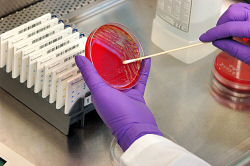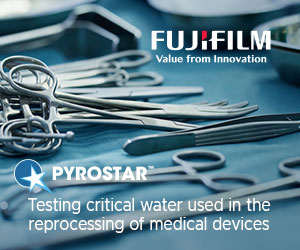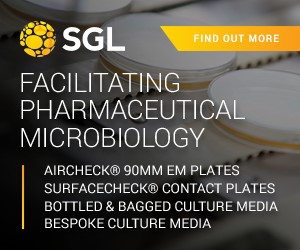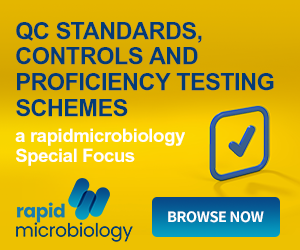QC Organisms and Nucleic Acids – Compliance, Applications, and Uses
Key points:
- Reliable QC cultures and nucleic acids are fully characterized and authenticated supporting compliance, accreditation, and validation of new test methods
- Suitable for use in assay validation, product testing, and proficiency testing
- Commercial products are available in a variety of presentations
- Normally only 5 subcultures or passes are acceptable from a type culture
 Reference materials are an essential part of any QC analysis as they help to ensure valid, reproducible results and testing consistency. In pharmaceutical, food, and clinical testing laboratories, routine QC analyses are necessary to ensure product quality and safety as well as the health and well-being of patients and consumers. These analyses typically form part of a testing laboratory’s compliance with quality management specifications required by regulatory and accreditation bodies. In the development of novel test methods, QC strains and nucleic acids also play an important role in assay validation with respect to ensuring analytical specificity and specificity as well as minimizing run-to-run variation.
Reference materials are an essential part of any QC analysis as they help to ensure valid, reproducible results and testing consistency. In pharmaceutical, food, and clinical testing laboratories, routine QC analyses are necessary to ensure product quality and safety as well as the health and well-being of patients and consumers. These analyses typically form part of a testing laboratory’s compliance with quality management specifications required by regulatory and accreditation bodies. In the development of novel test methods, QC strains and nucleic acids also play an important role in assay validation with respect to ensuring analytical specificity and specificity as well as minimizing run-to-run variation.
When performing QC assays, the use of minimally-passaged, qualified reference materials is essential in ensuring the accuracy and reproducibility of an assay. These controls should be traceable back to a known type culture with less than five subcultures or passes; repeated subculturing can be detrimental to QC as each passage carries the potential for contamination, drift, and mutation. Further, reference materials should be meticulously characterized and authenticated as this can help avoid the pitfalls of misidentification, product recalls, and regulatory repercussions. Currently, many organisms and nucleic acids for QC are available commercially in a range of different presentations. These materials are easy to store, convenient, economical, and most importantly, reliable and consistent. Formats include:
Qualitative
Reference materials representing a wide breadth of species or phenotypic, genotypic, or functional characteristics can be used to provide a yes/no answer
Quantitative
Titered and quantitative QC materials can provide numerical information about a sample
Matrix-enriched
Reference materials provided in a specified matrix can be employed in the QC of assays used to detect microorganisms in consumable, clinical, and environmental samples
Reporter-labeled
Labeled strains provide a readily measurable and distinguishable phenotype with applications in microbial quantification and detection, host-pathogen interaction studies, drug discovery and compound screening, in vivo imaging, and quality control
Synthetic
Synthetically derived nucleic acids representing key target regions from difficult-to-culture, unculturable, or high containment microorganisms
Mixed cultures
Mixed culture controls comprising genomic material or whole organisms that represent microbial communities from clinical specimens
Certified Reference Materials
Traceable materials produced under an ISO Guide 34:2009 accredited process that are homogenous and stable with respect to one or more specified properties
Proficiency Testing
Test materials for a specific homogenous analyte within a sample matrix
Quality control labs are evolving in their approach to different methods of testing. While some procedures are still based on the phenotypic characteristics of an organism, such as Gram stain or growth requirements, the advancement of genotypic assays, such as PCR or RT-PCR, have allowed for more rapid and sensitive analysis of test samples and analytes. Likewise, implementation of improvements in validation through proficiency testing have provided QC analysts with greater confidence in the reliability and reproducibility of their data by minimizing user error, run-to-run variation, and differences in instrument or assay capabilities. A wide range of applications and uses for QC strains and nucleic acids are described below:
Validation of phenotypic-based assays, test supplies, and reagents
The accuracy of an assay is dependent on the quality of the media, reagents, and instrumentation used. Authenticated QC strains and nucleic acids can be used to monitor the performance of these materials, helping to protect the quality of your results.
Media QC
The quality and functionality of culture media directly affects its use in microbiological assays. Media prepared in house need to be analyzed for sterility and quality, and will require various growth promotion tests according to GLP. Even commercially prepared media, where most of the QC testing work has already been performed, will require inspection in addition to limited growth promotion testing, particularly with media containing light- or heat-sensitive components.
Biochemical tests, kits, and slide stains
When using qualitative inoculants for assays, kits, and slide staining, the controls should reflect the organism(s) being tested for and demonstrate that the test was correctly performed. Slides for Gram and acid fast staining are available with positive and negative control organisms already incorporated.
Instruments
Commercial firms specify the use of authenticated QC materials for rapid identification, minimum inhibitory concentration of antibiotics, and antibiotic susceptibility analyses. Control materials should be meticulously authenticated and preserved to confirm and maintain phenotypic and genotypic characteristics, ensuring the reproducibility of results across time and among laboratories.
Determining Measurement of Uncertainty (MoU)
Because no method is perfect, the use of quantitative reference materials can help evaluate the amount of uncertainty, or variability, for a particular assay. Commercially prepared strains and nucleic acids are an easy, standardized way of using a known inoculum number and copy number, respectively
Molecular-based assay validation
Ensuring the accuracy of a molecular-based assay from nucleic acid extraction to data analysis is an important part of assay validation. Qualitative and quantitative biological and molecular controls are essential in ensuring analytical sensitivity and specificity as well as minimizing run-to-run variations.
Inclusivity/exclusivity testing
Establishing analytical specificity is an essential part of assay validation, particularly for the development of diagnostic and epidemiological assays whose results can affect public health. Authenticated nucleic acids representing a wide breadth of species or genotypes are ideal for evaluating an assay’s accuracy.
Determining Limits of Detection (LoD)
Confidence in the sensitivity of an assay can be obtained through validation with quantitated genomic and synthetic nucleic acids that have been evaluated for copy number.
External run controls
During assay development, or when using a pre-qualified assay or sequencing tool, it is important to select appropriate external controls to evaluate and verify the performance of each process as well as to track drift and run-to-run variation. These materials should encompass both positive and negative controls and should be well characterized for the analyzed target.
Product testing requirements
Biological and genomic reference materials are essential for protecting product quality and safety through the identification and detection of objectionable microorganisms in products or raw materials.
Antimicrobial efficacy testing or MIC determination
Reference strains of bacteria with known sensitivities are tested in parallel with a clinical culture to monitor the antimicrobial content of the discs/broths and the performance of the media and incubation conditions.
Preservative Efficacy Testing (PET)
By using quantitative preparations of known organisms, a product’s preservative system can be challenged and monitored using a reliable and consistent inoculum.
Microbiological examination of non-sterile products
Microbial strains representing known contaminants can be used as reference materials to identify the presence of microorganisms deemed to be objectionable in view of a product’s intended use, particularly concerning products that are not required to be sterile.
Identification of pathogens in food
Food products and raw materials can become contaminated during any stage in the process of food production to consumption. Biological and chemical certified reference materials can be used for method validation as well as the calibration of laboratory equipment and examination of new identification, detection, or cleaning methods.
Water testing
Authenticated biological and molecular reference materials can be used to protect public health and safety through the evaluations of consumable, recreational, pharmaceutical, and environmental water samples for objectionable microbial pathogens.
Proficiency testing
Biological, genomic, and chemical reference materials provided in an assay-appropriate matrix can be used to evaluate the analytical performance of testing laboratories, providing an external, objective means of assessing the quality, accuracy, and validity of analytical data produced in comparison to other laboratories throughout the world.
In summary, safety, reputation, and business performance depend on reputable QC programs and reference materials. Microbial strains and nucleic acids with confirmed identity, viability, and purity backed by meticulous laboratory procedures that minimize subculturing are important in ensuring reliable, reproducible results that contribute to product quality and consumer safety. With a wide range of applications and a number of available formats, these reference materials are an essential part of maintaining outstanding QC programs.
Get the latest updates in Rapid Microbiological Test Methods sent to your email?






